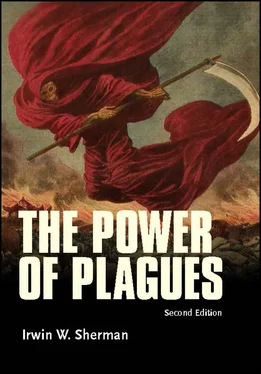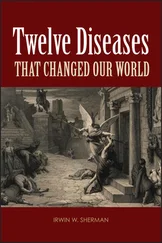1 Cover
2 Preface to the Second Edition
3 1 The Nature of Plagues
Living Off Others Plagues and Parasites Predicting Plagues A Measles Outbreak The Evolution of Plagues
4 2 Plagues, the Price of Being Sedentary Becoming Human, Becoming Parasitized The Road to Plagues: More Humans, More Disease The Effect of Agriculture The Lethal Gifts of Agriculture The Accident That Caused Societal Differences
5 3 Six Plagues of Antiquity The Pharaohs’ Plague The Plague of Athens The Roman Fever Plagues and the Rise of Christianity The Antonine Plague The Cyprian Plague The Justinian Plague
6 4 An Ancient Plague, the Black Death A Look Back Public Health Discrimination Church Medicine Education Economy and Social Order Finding the Killer Finding the Vector The Disease of Plague The Plague-Causing Bacterium, Yersinia pestis Plague Today Vaccines Coda
7 5 A 21st Century Plague, AIDS A Look Back HIV Discovered The Genes of HIV HIV Targets Immune Cells HIV and AIDS Failure To Control by Antibody or Vaccine AZT, the First Antiretroviral Drug Beyond AZT “Catching” HIV Control of AIDS HIV and the African Connection The Sooty Mangabey Connection: HIV-2 The Social Context of AIDS
8 6 Typhus, a Fever Plague A Look Back Typhus in People Finding the Killer A Lousy Business Discrimination and Dissemination Typhus and the “Immigrant Problem” Typhus Today Typhus Vaccine Coda
9 7 Malaria, Another Fever Plague A Look Back The Disease Malaria “Catching” Malaria Malaria Today Treatment Prevention of Malaria Genetic Resistance to Malaria: Sickle Cell Trait and Duffy Factor The Elusive Malaria Vaccine Coda
10 8 “King Cholera” A Look Back The Disease Cholera Pandemic Cholera Death by Dehydration ”Catching” Cholera Controlling Cholera Cholera, Sanitation, and Public Health John Snow, the Father of Epidemiology Cholera Today Cholera and Nursing Cholera and the “Immigrant Problem” Coda
11 9 Smallpox, the Spotted Plague A Look Back The Disease of Smallpox “Catching” Smallpox Variolation Vaccination Vaccination and Its Social Context Coda
12 10 Preventing Plagues: Immunization The Immune System Inflammation and innate immunity Acquired immunity Clonal selection theory Autoimmunity Diphtheria Emil Behring and serum therapy Paul Ehrlich Toxin, antitoxin, and toxoid Diphtheria today Diphtheria, whooping cough, and the DTaP vaccine Why Do Antibodies Work? Attenuation and Immunization Influenza Measles Mumps Rubella Whooping Cough Chickenpox Polio John Enders Jonas Salk Albert Sabin Aftermath Cell-Mediated Acquired Immunity Coda
13 11 The Plague Protectors: Antisepsis to Antibiotics Barbers, Bloodletting, and Antisepsis Surgery, Disease, and Anesthesia Laughing gas Ether Chloroform Disease, Dyes, and Drugs Prontosil Penicillin Aftermath Antimicrobial Resistance How AMR is acquired What can be done about AMR? Coda
14 12 The Great Pox Syphilis A Look Back Spirochete Discovered The Disease Syphilis “Catching” Syphilis Syphilis and Its Social Context Diagnosing Syphilis Treating Syphilis Syphilis and the Social Reformers Distribution and Incidence of Syphilis Vaccines against Syphilis Coda
15 13 The People’s Plague: Tuberculosis A Look Back The Germ of TB The Disease of TB Today’s Diagnosis of TB Heroin and TB Controlling Consumption Selman, Schatz, and Streptomycin Drug Resistance Drug Resistance Redux Vaccination against TB Incidence of TB Coda
16 14 Leprosy, the Striking Hand of God A Look Back The Disease of Leprosy Where Leprosy Is Leprosy Today “Catching” Leprosy Coda
17 15 Six Plagues of Africa Slavery and European Exploration Endemic Diseases of Africa Plagues Out of Africa
18 16 Emerging and Re-emerging Plagues Blame It on the Rodents On the Wings of Birds Anthrax Robert Koch Louis Pasteur Madness and the Infectious Protein Ebola Zika Disease Lyme Disease The Conquest of Plagues
19 Appendix Cells and Viruses
20 Notes
21 Bibliography
22 Index
23 End User License Agreement
1 Chapter 11Table 11.1 Timeline of the discovery, introduction and year of resistance of ant...
1 Chapter 1 Figure 1.1 Woman with Dead Child. Kathe Kollwitz etching. 1903. National Gallery... Figure 1.2 The Plague of Ashod by Nicolas Poussin (1594-1665). The painting prob...
2 Chapter 2 Figure 2.1 Hollywood’s view of Australopithecus as seen in the movie 2001: A Spa... Figure 2.2 Australopithecus reconstruction of Mr. and Mrs. Lucy. Courtesy of Ken... Figure 2.3a Oldowan tools used by Homo habilis, Courtesy Didier Descouens, CC-BY... Figure 2.3b Diorama in the Nairobi National Museum of Homo habilis, Figure 2.3c Acheulean tools used by Homo erectus, Courtesy Didier Descouens Figure 2.3d Diorama of H. ergaster the “African equivalent” to fossils of H. ere... Figure 2.4a Neanderthal man in profile; Neanderthal woman cleaning a reindeer sk... Figure 2.4b A 1953 B- grade movie poster representing a monster-like Neanderthal... Figure 2.4c Neanderthal Family, Reconstruction. Ian Tattersall, American Museum ... Figure 2.5 A. Growth of the human population for the last 500,000 years. If the ...
3 Chapter 3 Figure 3.1 Plague in an Ancient City (detail) circa 1652-1654 by Michiel Sweerts... Figure 3.2 The blood fluke Schistosoma, causative agent of the Pharoah’s Plague.... Figure 3.3 Two young boys infected with blood flukes Figure 3.4 St. Sebastian in a painting by Andrea Mategna (1490) in Ca d’ Oro, Ve...
4 Chapter 4 Figure 4.1 The Plague by Felix Jenewein (1900) shows a mother carrying a coffin ... Figure 4.2 Triumph of Death by Pieter Brueghel (1562), Courtesy Wellcome Library... Figure 4.3 St. Roch, the patron saint of those suffering from plague. The origin... Figure 4.4 Dr. Pestis, the plague doctor in costume, Courtesy Wikipedia.com Figure 4.5 A barber-surgeon lancing a bubo. Woodcut Figure 4.6 A. Bubo of bubonic plague (courtesy of CDC, 1993) and B. the causativ... Figure 4.7 Flea as seen with the scanning electron microscope. Courtesy CDC/Jani...
5 Chapter 5 Figure 5.1 A sketch by the author of Lorraine aged 11, who has AIDS, comforted b... Figure 5.2A A scanning electron microscope image of HIV budding from the surface... Figure 5.3 A diagrammatic view of the human immunodeficiency virus (HIV) when sl... Figure 5.4 The life cycle of the retrovirus. The virus attaches to the cell, and... Figure 5.5 Clinical characteristics of an HIV infection. At 1, virus production ...
6 Chapter 6Figure 6.1 Napoleon’s troops in Vilna after the Russian Campaign in 1812. Engrav...Figure 6.2 Typhus rash. Courtesy medbullets.com.Figure 6.3 Pediculus humanus humanus (body louse). Courtesy CDC/ Dr. Dennis Jura...Figure 6.4 An unhatched nit containing a developing head louse. Courtesy CDC/Dr....Figure 6.5 Rickettsia prowazekii as seen with transmission electron microscope, ...Figure 6.6 The Louse Hunt by Gerhard ter Bosch (1617-1681) Mauritshuis, The Hagu...
7 Chapter 7Figure 7.1 A Thai mother attends her sick child suffering from cerebral malaria....Figure 7.2 Laveran’s drawing of what he saw under the light microscope when exam...Figure 7.3 Ronald Ross’ pen and ink drawing of a mosquito stomach with oocysts (...Figure 7.4 (A) Method of staining blood film (Courtesy CDC/Dr. Mae Melvin, 1977)...Figure 7.5 The world distribution of malaria (prior to the WHO eradication campa...Figure 7.6 The worldwide distribution of malaria in the 1930s prior to the WHO e...Figure 7.7 The inheritance of sickle cell hemoglobin. The mating of two individu...
8 Chapter 8Figure 8.1 Death’s Dispensary. From the Illustrated London News 1860.Figure 8.2 Pasteur’s swan neck flask. Courtesy Wellcome Library, London, CC-BY-4...Figure 8.3 Rice water stools. Courtesy Wikimedia Commons/F1jmm, CC-BY-SA 3.0.Figure 8.4 Villagers from Pimpri fetch water from a polluted river which is not ...Figure 8.5 Vibrio cholerae stained and viewed with the light microscope. Courtes...Figure 8.6 The one-eyed copepod, Cyclops (blickwinkel/Alamy Stock Photo).Figure 8.7 “A Court for King Cholera” from Punch in 1852. Courtesy of the Wellco...
Читать дальше












